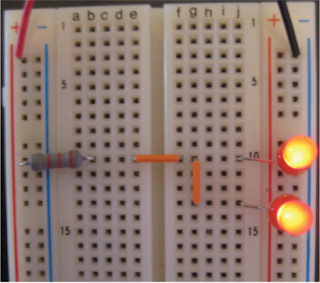voltage divider in action

Resistors can be used also to reduce the voltage supplied to different parts of a circuit. »» One 6-volt battery (4*1.5) »» jumper wire »» One 2.2 kΩ resistor »» One 3.3 kΩ resistor »»breadboard Next, use your multimeter set to volts DC to measure the voltage across the bat- tery and across the resistors. My measurements show that the actual battery voltage is 4.8 V Vout (the voltage across the 2.2kΩ resistor) is 1.9 V. and Vout (the voltage across the 3.3kΩ resistor) is 2.9 V. and



